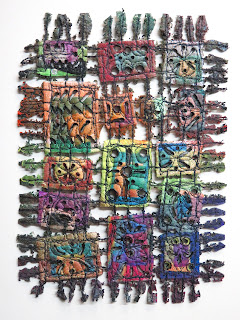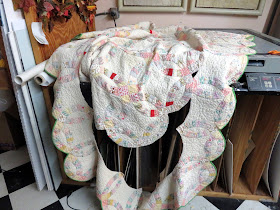Since returning from Espanola, Canada, Steve and I have been working like crazy people! There's so much to do, especially since we leave early tomorrow morning for Fort Myers, Florida. I'm so happy that my three recent garments made from recycled materials will be in the Trashion Fashion Show this coming Friday night at the Sidney & Berne Davis Art Center. What makes this extra special is that these three dresses are currently featured in Fiber Art Now Magazine. I am truly indebted to Noelle Foye for such a beautiful article.
(Above: The Class of 1949 and the Red Carpet Dress in the store front window at the Tapps Art Center.)
Before going, I had to retrieve the dresses from the large, corner window at the Tapps Art Center where they've been on 24/7 display since the ecoFAB Trashion Show on August 31st. For this earlier opportunity, the garments were paired with both a 2D and 3D creation. In the background of the photo above appears A Picture of a Plant, the 2D creation using vintage photo album pages and pressed flowers to make a statement about plant extinction. It goes with The Class of 1949 dress and the Black Lives Matter fan as well as the 3D piece, the Anonymous Ancestors Folding Screen. The screen will next be on display at the 701 CCA South Carolina Biennial.
The Red Carpet Dress was paired with an altered circus poster and Red: A Biomorphic Abstraction (basically a really, really large boa made from the same floor covering as the dress). It's almost shocking to think that as soon as we return from Florida, we are headed back to the Philadelphia Museum of Art Craft Show ... the place where I rescued a section of the red floor covering!
(Above: You Are My Sunshine in the store front window at the Tapps Art Center.)
The third dress in the store front window was You Are My Sunshine. It was paired with one of my Things Kept 2D pieces and all the altered cigar boxes made at the Osage Arts Community residency in Missouri. This dress will stay in Fort Myers for the run of the Turf Wars Exhibition at the Sidney & Berne Davis Art Center. Yet, these three dresses are only half the garments making the trip. I'm so happy that my Pantyhose Dress, Leaf Dress, and Flower Dress are also going to be on the runway! I am passionate about how art can bring awareness to issues of global warming, the need to "reduce, reuse, recycle", and ways in which individuals can be part of a movement to impact positive environmental change.
(Above: Relic CXXIII. Framed: 13" x 11 1/2". Inventory # 4622. $100.)
As much as I'm looking forward to the weekend, this past week has also been about finishing up projects from the immediate past ... including the "relics" made while conducting the two workshops for the Espanola Fibre Festival. As a workshop instructor, I feel it very important that I'm NOT just giving another "example" or making another "sample". I always finish, frame, price, and put into inventory every demonstration I start while teaching ... including these five pieces.
(Above: Relic CXXII. Framed: 12 1/4" x 11". Inventory # 4622. $100.)
I use scraps of picture frame moulding and leftover mats and fillet to frame these works. They are never sold through galleries but serve as examples for future workshops. I price them so that just about anyone who wants one can afford one. I like the title "relic" because it indicates something remaining from the workshop experience ... something precious, something meaningful, something that possesses the energy and significance of sharing my processes with others.
(Above: Relic CXXIV. Framed: 13" x 11 1/2". Inventory # 4624. $100.)
In Canada, one participant arrived after my first demonstration ... so I did that demonstration again. That's why there's an odd number of Relics!
(Above: In Box Relic CXXV. Framed: 13 1/4" x 11 1/4". Inventory # 4625. $60.)
On the second day of the two workshops, my demonstration pieces are melted with both the soldering irons and the heat gun. I finish them too!
(Above: In Box Relic CXXVI. Framed: 12" x 10". Inventory # 4626. $60.)
It is fun to think about having talked through these demonstrations. It is a challenge to finish them since I wasn't truly paying attention while initially working! I was "teaching". Then, I have to "fix" whatever shifted or went slight awry! Challenges are always good! They force me to solve problems that I wouldn't otherwise encounter!
(Above: Altered Cross Stitch: Most Enemies [Can Be Paid Well Enough to Simply Go Away.] Framed: 24" x 21". Inventory # 4627. $400.)
There's no way for me to work on pieces from my workshop while riding in our cargo van. Beads just don't cooperate with bumpy roads and sharp curves. So, I brought along another piece from my Alter Cross Stitch Series. These pieces position anonymously stitched vintage cross stitches on darker linen. I've stitched updated phrases around each one and then densely applied running stitches over the entire surface. These running stitches unite the old with the new. It is easy to ply Appleton wool thread while in the cargo van!
(Above: Altered Cross Stitch: Most Enemies [Can Be Paid Well Enough to Simply Go Away.], detail.)
The vintage cross stitch was donated to me by a friend. She added some of her own seed stitches to the original border. It is a lovely thing to know that at least three women worked on this piece!
(Above: Altered Cross Stitch: Most Enemies [Can Be Paid Well Enough to Simply Go Away.], detail.)
Although I have two more vintage cross stitches on which I might work. I haven't started on them yet. The day might come ... but it might not. Lately, I've been thinking about the several series that I have and return to and think about and work on. I seem to need the ability to jump from one to the other, especially between major projects. I don't seem capable of always making my "signature" work, my In Box and Stained Glass Series. I need diversity, a "stitch vacation", a momentary way to "play" with other ideas and project. In fact, I occasionally need a simple lark!
(Above: Autumn Leaves, in progress.)
Such was the case this past week. When taking apart two very old framed pictures for a client, I found two pieces of acid-free barrier paper used to buffer the antique engraving from the acid-filled corrugated backing. (Okay ... I admit it ... back in the mid-1980s, I did this too! The idea was to "protect" the artwork from the inferior backing. Of course, the barrier paper absorbed the acid, staining it ... and over time the acid would eventually effect the image. But this was the mid-1980s. Most custom picture framers were just learning about conservation material, and I was just learning to frame ... period. Naturally, I quickly changed to using acid-free materials!) Anyway, the client's engravings look perfectly fine, and I was about to toss the acid-damaged barrier paper ... before a hair-brained idea occurred to me! Why not use them for an experiment?!
I picked up five leaves outside my house, taped them gently to the barrier paper, and sponge painted around the shapes. I then flicked black ink specks over the surface.

For the paint, I mixed up a watery solution of brown acrylics that sort of matched the acid-stain on the barrier paper. I used a unique "brush" that another artist gave me. Instead of bristles, pieces of chamois are affixed in a seemingly random arrangement on a handle. It works perfectly!
(Above: Autumn Leaves, in progress.)
I liked what I saw but knew it really wasn't enough!
(Above: Autumn Leaves in Ink. 14 1/4" x 17". Inventory #4628. Shrink-wrapped. $50.)
On one piece, I used my rapidograph to draw the outline and veins of the leaves. I added gold lines around the edge, including dips that marked the hinges for the engraving. Then I added a French line. As a picture frame who once specialized in antiquarian prints, I'm a good "French matter".
(Above: Autumn Leaves in Stitches. 12" x 17 1/2". Inventory #4629. Shrink wrapped. $50.)
I fused a piece of fabric to the back of the darker painted piece and then free-motion stitched the veins, outlines, and the perimeters. A gold and rapidographed French line finished the work.
(Above: Detail with signature.)
These two pieces took less than an hour to complete. They were a fun experiment, a great way to use an old piece of barrier paper (which is probably now PH balanced similar to paperback books printed during World War II), and a way to keep my mind excited in the studio. In my opinion, acting on hair-brained ideas and simply "playing" is the best way to keep engaged and productive. Odds are that these two pieces will never be in a show, never hang on a wall, never be cherished or saved or valued beyond a listing in my inventory book. Yet, they are important. They are the momentary thrill that keeps me on my toes. They are the diversions from the "normal work" that permits me to keep up a busy schedule!


























































